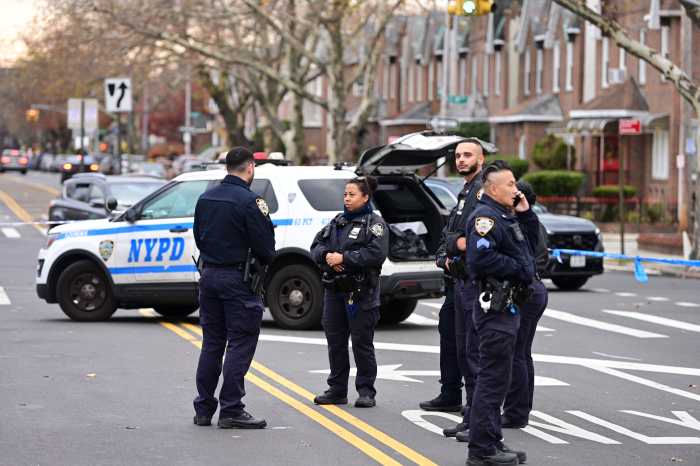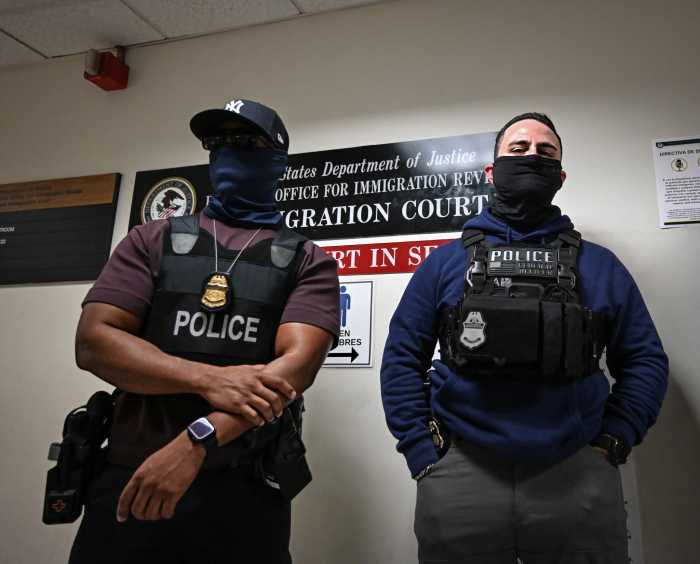A $10 drag show staged by a Mississippi performer in town for only two nights led to the shuttering of a Chelsea bar as police scrambled to contain a crowd of about 50 demonstrators who turned out to protest what they have termed the “misogyny, racism, and classism” of the act created by a gay white man in blackface.
In response to the protest and subsequent closing of the club, a heated debate has opened up between those citing the need to confront bigotry wherever it is found and others defending the rights of free speech and artistic expression. Though the two sides in the debate see little of merit in the views of their opponents, both camps agree that the incident also points up the ease with which free speech and public discourse can be shut down under the current quality of life climate enforced by police.
The incident, which took place Friday evening, September 13, centered on a comic performance by Chuck Knipp, a gay white man who lives outside of Biloxi on Mississippi’s Gulf Coast. Knipp was in town for two performances, including one the previous evening, at View Bar, on Eighth Avenue just below 22nd Street. Knipp performs his show as a character Shirley Q. Liquor, a southern black woman on welfare who is unmarried and has 19 children. The show played to a sold-out audience on Thursday night.
According to Clarence Patton, an official at the New York City Gay and Lesbian Anti-Violence Project (AVP), his group received a phone call from an African American man on Friday who had seen the show the previous evening and was offended by Knipp’s performance. Patton understood the man to be concerned that the show harked back to the blackface vaudeville of Al Jolson and other white performers that thrived at the height of the Jim Crow era prior to World War II. African Americans typically found the depictions by blackface performers demeaning and as blacks made social, political, and legal strides in the years after the War, such entertainment fell out of favor, losing its social acceptability.
Patton and other activists, including Gary English, director of People of Color in Crisis, an AIDS service organization in Brooklyn, Joo-Hyun Kang, who heads up the Audre Lorde Project, a queer community center for people of color, also in Brooklyn, and Colin Robinson, executive director of the New York State Black Gay Network, scrambled to learn more about Knipp, doing research on the Internet and visiting his website at www.shirleyqliquor.com.
According to the activists, what they found reinforced the concerns originally brought to AVP’s attention, and plans for a demonstration that evening were hatched.
By the time that patrons were gathering to enter the View, a crowd of about 50 demonstrators had gathered to protest that evening’s show.
Patton, who often works with the police department in connection with AVP’s role as a victims’ advocate, said he had phoned police headquarters during the day Friday to informally advise them to expect a protest and was assured there should be no problem with that. However, shortly after the crowd gathered, it was approached by two police officers who Patton said “really seemed to be insensitive and relatively incapable of handling the situation.” Patton said he approached the officers and asked if they wanted the crowd to begin to circulate, which the police generally prefer in order to avoid congestion that could spark a confrontation. According to Patton, the officers responded that simply circulating would not be enough, that if the protesters failed to move along they would receive summonses requiring court appearances. When Patton challenged the validity of that threat, the officers said they would have to speak with their sergeant.
According to all accounts, by the time the sergeant arrived to take charge of the situation, a sanitation truck had suffered a traffic accident close to the bar, creating further confusion and tension, and bringing out another two dozen cops.
When the sergeant finally arrived, Patton said that he once again offered to urge his fellow protesters to start moving to clear up congestion. In response, the police official said that wouldn’t be necessary.”
“I’m going to shut them down,” Patton recalls being told.
“There was a little bit of disbelief when I heard that,” Patton said. “When I had asked one of the first cops on the scene, ‘Is there a problem?,’ he replied, ‘There shouldn’t be people out here screaming and shouting. You don’t think that’s a problem?’ It was clear that there wasn’t an interest [on the part of the police] in public discourse.”
The account of what led up to the bar’s closing given by owners of the View differs significantly from that of Patton and other protesters.
“In their release [issued by protesters] it states that it was never their intention to have the bar closed, yet the protesters were chanting, ‘Close this bar,’” according to a statement issued by Lee Brandt, one of the partners who owns the View.
Brandt said that he reached out to Gary English from POCC several days after the protesters issued their press release.
“He said he never wanted to shut us down but that’s hard to believe,” Brandt said.
For Brandt, the issue is an open and shut free speech case, and he sees overreaction not only by the demonstrators, but also by the police.
“Having a business shut down without full investigation is blatant censorship,” Brandt said.
Of course, there are not simply two sides to this story. The police offer a third perspective.
“The police did not close the bar,” according to Detective Cusick, a community affairs officer at Manhattan’s 10th precinct. “The sergeant asked them to close to defuse the situation and the club agreed.”
Cusick went on to say, however, that the two charges for which the club received summonses to appear in court ––disorder in a licensed premises and failure to control a crowd––reflect standard operating procedure in such situations. He said that nightclub establishments have a responsibility to control crowds both inside and outside their premises but said that while he could not predict what a judge might do, he doubted that any fine levied on the club would be “anything extravagant.”
“I am sure we are going to be fined,” Brandt said, offering his own prediction.
The protesters took pains to emphasize that whatever rhetoric might have been bandied about by some in the crowd, the intention of the organizers was never to shut the club down. In fact, several of the leaders specifically aligned themselves with the nightclub regarding concerns about the arbitrary nature of quality of life enforcement in the city.
“We have all condemned the fact that the police closed down the club,” said Audre Lorde’s Joo-Hyun Kang. “We see that as part of the ongoing quality of life crackdown that often singles out our communities.”
“We’re all clear that everyone knows he has the right to perform and that we have the right to protest,” said Patton. “The police action was connected to other larger quality of life issues. In this context, it served a dual purpose. It shut down protest, which is a goal of the quality of life campaign. And, at least temporarily, it shut down the bar, which is also often a goal.”
Patton expressed the hope that the incident will spark a broader debate about stereotyping and what the appropriate responses to it are within the LGBT community.
Knipp himself claimed to be surprised by the furor his appearance touched off, and dismissed the possibility that serious community issues are stake.
“The first night went really very well,” Knipp said, from his home on the Gulf Coast. “Then, on Friday, as I was getting into my make-up, I was told that the club had been shut down by a protest. I was astonished.”
Knipp said he never faced protests before and that many African Americans are among his fans. He said the Shirley Q. Liquor character is affectionately modeled on his family’s housekeeper, Fannie Mae Turner of Monroe, Louisiana and other black women he met as a child. He said he first played with accents, including Cajun and “Ebonics” as a childhood class clown, and developed the Shirley Q. character while he played in the band at Ole Miss, the University of Mississippi. Later, he used the voice on his answering machine, and was soon doing radio gigs.
Performing live was a challenge, Knipp explained, because he had never before done drag.
He seemed eager to downplay questions about using blackface.
“My outfits for the stage are home-made and of course Shirley Q. is black and I of course try to look a little more black,” Knipp told Gay City News.
In a biography sent to Gay City News by the View, Knipp is quoted saying, “Some people ask if I do blackface. I don''t think that''s it. I use regular African-American lady brown foundation and all kinds of eye shadows.”
Knipp, a nurse by profession and a Quaker by faith, rejected charges of racism.
“I certainly am not a white supremacist,” he said. “I am against racism.”
But noting that “we all do have cultural differences” and that he “always had a very strong ear for black accents,” Knipp argued that his show is meant to challenge negative images of blacks, women, poor people, and Southerners.
“I’m sorry that people who protested felt the way they did,” he said. “But, I do stereotype-busting comedy. They are not seeing the absurdity that I am trying to bring to light. They probably think it’s a reprise of Amos ‘n’ Andy or Al Jolson.”
Knipp pointed to a portion of his routine in which he roasts “ignunt” white people.
Knipp also argued that many of his biggest fans are African Americans, as are many, though by no means all of his critics. Just the same, Knipp also made clear that even as he reaches out to the protesters, he is willing to take them on politically as well.
“I just hope [the critics] are not professional victims. I looked at their website and they look like they have a protest every week,” he said, not specifying to which group he was referring. “It seems like maybe they want no part of any entertainment if it is not completely politically correct and sterile.”
One of Knipp’s most high profile African American fans was much blunter in taking on his critics.
“A group of unsophisticated barbarians with misguided rage are protesting and calling for the boycott of one of my favorite entertainers, Shirley Q. Liquor,” wrote Rupaul Charles in response to an email query from Gay City News. “These fascists believe that Mr. Knipp ‘not only makes fun of black women, but re-enforces every racist stereotype.’ That argument was valid 40 years ago, before there were black media moguls who make fun of black women and reinforce racist stereotypes. I guess the rap and hip-hop community is exempt because they appear to be black. Chuck Knipp is an easy target, as easy as yelling ‘fire’ in a crowded theater. When Chuck performs as Shirley Q., it’s very clear to me that he is paying a loving homage to the southern black women that he obviously grew up around.”
But Knipp’s critics aren’t buying any of the explanations Knipp and his fans offer.
Kang spent considerable amount of time checking out Knipp’s website and didn’t find anything that challenged stereotypes. Noting that Audre Lorde, for which the center she runs is named, did political art, Kang said, “There is nothing on his website that even approaches satire. There are mostly just messed up images of African Americans and of women.”
English, who said that the website “looked like a Klan site” when he looked at in advance of the protest, noted that a number of images of Aunt Jemima and of the Confederate flag have since been removed.
Nevertheless, the site still contains numerous pictures of Knipp in blackface drag as well as other pictures of African American women either distorted, portrayed in Black Sambo style, or with blackface apparently added. One portrays a group of children at Mount Holy Olive School, their faces blackened beyond recognition.
“There is clearly no attempt at satire or parody,” argued Patton. “Let’s assume there is and I missed it. If you fail at satire, you veer off into offense. What you have is a performer who really takes on what would probably be problematic for anyone, and without any eye to nuance, it can be offensive, and even stupid.”
Patton also disputed that African Americans are a major part of Knipp’s audience, noting that only about 10 percent of the crowd waiting in line at the View was black. He said that his research on the Internet suggests that Shirley Q. is most popular among country music and album-oriented-rock stations and among the gay circuit crowd, none of them venues known for strong black participation.
Activists have begun circulating a community sign-on letter aimed at exposing what they view as Knipp’s racism, discouraging other gay venues nationwide from hosting him, winning apologies from groups that supported his appearance in New York, and broadening the discussion of the issues they believe this incident raised.
The letter has already won the support of about 40 community organizations, including the African Ancestral Lesbians United for Societal Change; Al-Fatiha, LGBTQ Muslims & Friends; Astraea Lesbian Action Foundation; the Colombian Lesbian & Gay Association; the Empire State Pride Agenda; the queer youth organization FIERCE!; Gay & Lesbian Dominicans Empowered; Gay Asian & Pacific Islander Men of NY; GLAAD; Jews for Racial & Economic Justice; the Latino Commission on AIDS; the Latino Gay Men of NY; the New York Association for Gender Rights Advocacy; SAGE; and the Unity Fellowship Church.
For its part, the View, while open to a discussion with activists, is not certain what it will accomplish.
“Drag queens are by nature not politically correct,” said Brandt. “If people are going to protest every single woman should be protesting every drag queen. It’s a man in a dress… I stand behind our choice to present Shirley Q. Liquor and the fact that we were sold out should be testimony to our choice.”
Next and HX magazines, which ran advertisements and editorial listings and also came under criticism from the protesters, both told Gay City News that they are willing to sit down with activists to hear their concerns. A meeting between Next and the protesters is scheduled for next week.
To read the full text of the community sign-on letter circulated by protesters, visit Open Letter.
To read the full text of Rupaul Charles'' defense of Chuck Knipp,
visit Letter from Rupaul Charles.











